AIM is going to retire by this month ............Please go through the below link for complete information
Retirement of Oracle Application Implementation Method (AIM)
Oracle Applications Functional 11i and R12
Specially For Job Seekers and Beginners...by Cnubandi
Tuesday, March 22, 2011
Sunday, February 13, 2011
R12 Features
Release12 introduces a better user experience, resulting in increased productivity and reduced training and support.
Examples of a better user experience include:
1.Reduced pop-ups and duplicate screens
2.Re-designed and streamlined entire work flows
3.Reduced the number of steps to complete key tasks
4.Improved look & feel and visual style
5.Increased personalization capabilities
6.Lower Costs
7.Fewer errors and
8.Stronger Internal Controles
Whats New in Release 12
Ledgers and Ledger Sets
Legal Entity Configurator
Rules-based Accounting Engine
Global Tax Engine
Global IntercompanySystem
Unified Bank Account Model
Single Sign-On Across Operating Units
Examples of a better user experience include:
1.Reduced pop-ups and duplicate screens
2.Re-designed and streamlined entire work flows
3.Reduced the number of steps to complete key tasks
4.Improved look & feel and visual style
5.Increased personalization capabilities
6.Lower Costs
7.Fewer errors and
8.Stronger Internal Controles
Whats New in Release 12
Ledgers and Ledger Sets
Legal Entity Configurator
Rules-based Accounting Engine
Global Tax Engine
Global IntercompanySystem
Unified Bank Account Model
Single Sign-On Across Operating Units
Monday, April 14, 2008
Period closing Process for Payables
Period closing Process for Payables
You cannot close a period in Payables if any of the following conditions exist:
o Outstanding payment batches. Confirm or cancel all incomplete payment batches.
o Future dated payments for which the Maturity Date is within the period but that still have a status of Issued.
o Unaccounted transactions. Submit the Payables Accounting Process to account for transactions, or submit the Unaccounted Transaction Sweep to move any remaining unaccounted transactions from one period to another.
o Accounted transactions that have not been transferred to general ledger. Submit the Payables Transfer to General Ledger process to transfer accounting entries.
To complete the close process in Payables:
1. Validate all invoices.
Run Invoice Validation Concurrent program.
2. Confirm or cancel all incomplete payment batches.
3. If you use future dated payments, submit the Update Matured Future Dated Payment Status Program. This will update the status of matured future dated payments to Negotiable so you can account for them.
4. Resolve all unaccounted transactions.
Submit the Payables Accounting Process to account for all unaccounted transactions. Review the Unaccounted Transactions Report. Review any unaccounted transactions and correct data as necessary.
Then resubmit the Payables Accounting Process to account for transactions you corrected. Or move any unresolved accounting transaction exceptions to another period (optional).
o Payables Accounting Process.
o Submit the Unaccounted Transactions Sweep Program.
5. Transfer invoices and payments to the General Ledger and resolve any problems you see on the output report:
o Payables Transfer to General Ledger Program.
6. In the Control Payables Periods window, close the period in Payables.
o Controlling the Status of Payables Periods.
7. Reconcile Payables activity for the period. You will need the following reports:
o Accounts Payable Trial Balance Report (this period and last period).
o Posted Invoice Register.
o Posted Payment Register.
8. If you use Oracle Purchasing, accrue uninvoiced receipts.
9. If you use Oracle Assets, run the Mass Additions Create Program transfer capital invoice line distributions from Oracle Payables to Oracle Assets.
10. Post journal entries to the general ledger and reconcile the trial balance to the General Ledger.

You cannot close a period in Payables if any of the following conditions exist:
o Outstanding payment batches. Confirm or cancel all incomplete payment batches.
o Future dated payments for which the Maturity Date is within the period but that still have a status of Issued.
o Unaccounted transactions. Submit the Payables Accounting Process to account for transactions, or submit the Unaccounted Transaction Sweep to move any remaining unaccounted transactions from one period to another.
o Accounted transactions that have not been transferred to general ledger. Submit the Payables Transfer to General Ledger process to transfer accounting entries.
To complete the close process in Payables:
1. Validate all invoices.
Run Invoice Validation Concurrent program.
2. Confirm or cancel all incomplete payment batches.
3. If you use future dated payments, submit the Update Matured Future Dated Payment Status Program. This will update the status of matured future dated payments to Negotiable so you can account for them.
4. Resolve all unaccounted transactions.
Submit the Payables Accounting Process to account for all unaccounted transactions. Review the Unaccounted Transactions Report. Review any unaccounted transactions and correct data as necessary.
Then resubmit the Payables Accounting Process to account for transactions you corrected. Or move any unresolved accounting transaction exceptions to another period (optional).
o Payables Accounting Process.
o Submit the Unaccounted Transactions Sweep Program.
5. Transfer invoices and payments to the General Ledger and resolve any problems you see on the output report:
o Payables Transfer to General Ledger Program.
6. In the Control Payables Periods window, close the period in Payables.
o Controlling the Status of Payables Periods.
7. Reconcile Payables activity for the period. You will need the following reports:
o Accounts Payable Trial Balance Report (this period and last period).
o Posted Invoice Register.
o Posted Payment Register.
8. If you use Oracle Purchasing, accrue uninvoiced receipts.
9. If you use Oracle Assets, run the Mass Additions Create Program transfer capital invoice line distributions from Oracle Payables to Oracle Assets.
10. Post journal entries to the general ledger and reconcile the trial balance to the General Ledger.

Wednesday, January 23, 2008
Data Load
Data load is the tool to Load data into any application running in Windows, and contains extra functionality for loading data and setup into Oracle Applications. Means we can load data through front end forms. To load data using Data Load you setup Data Load to load into the forms and the forms load the data into your system. Non technical users can also use this tool.
SOX
The Sarbanes-Oxley Act of 2002, also known as the Public Company Accounting Reform and Investor Protection Act of 2002 and commonly called SOx or Sarbox; is a United States federal law enacted on July 30, 2002,To improve quality and transparency in financial reporting and independent audits and accounting services for public companies, to create a Public Company Accounting Oversight Board, to enhance the standard setting process for accounting practices, to strengthen the independence of firms that audit public companies, to increase corporate responsibility and the usefulness of corporate financial disclosure, to protect the objectivity and independence of securities analysts, to improve Securities and Exchange Commission resources and oversight, and for other purposes
Friday, December 7, 2007
Accounts Payables Frequently Asked Questions
1. What are the types of invoices?
2. What is difference between debit memo and credit memo?
3. What is meant by with-holding tax invoice?
4. What are the mandatory setups in AP?
5. What is the difference between PO default and quick match?
6. Use of recurring invoice?
7. Steps for payment batch?
8. Purpose of Payable invoice open interface?
9. Payable open interface import? (Expense Report Import)
10. Multi Currency payments?
11. Can we implement MRC at Payables?
12. Use of Distribution set?
13. Accounting Methods?
14. Use of automatic offset method?
15. What does the Unaccounted Transaction Sweep Report do?
16. What reports should I run before closing the period?
17. What is the program to transfer data from AP to GL?
18. What is meant by void payments?
19. What are the types of journal categories available in the AP?
20. What is meant by matching and what are the types of matchings available?
21. Types of Prepayments? And difference between them?
22. What is a Hold and Release
23. How to approve ‘n’ no. of invoices
24. What is Zero-Payment in AP
25. What is Proxima Payment Terms?
26. What are the tables associated with Invoice?
27. Which interface tables are used for Invoice Import?
28. What is 2 way, 3 way and 4 way matching?
29. What is Interest Invoice and how it can be created?
30. How many key flexfields are there in Payables?
31. Can you cancel the invoice? If yes, explain?
32. What is pay date basis?
33. What is terms date basis?
34. What is the report used to identify duplicate suppliers?
35. Difference between header level tax calculation and line level tax calculation?
36. What is meant by accrual write off?
37. Difference between quick payment and manual payment?
38. Use of Future dated payments?
39. Tell me steps for Period closing Process in AP?
40. Payable And Financial options?
41. What is meant by third party payments?
42. How to transfer funds between your internal banks?
43. Invoice Approval Process?
44. Can I find out which invoices are matched to a PO?
45. What is Intercompany Invoicing?
46. ERS Invoice means?
47. Use of Pay on receipt auto invoice?
48. What is meant by RTS transactions?
49. What are the steps to define a Bank?
50. Payment Methods?
2. What is difference between debit memo and credit memo?
3. What is meant by with-holding tax invoice?
4. What are the mandatory setups in AP?
5. What is the difference between PO default and quick match?
6. Use of recurring invoice?
7. Steps for payment batch?
8. Purpose of Payable invoice open interface?
9. Payable open interface import? (Expense Report Import)
10. Multi Currency payments?
11. Can we implement MRC at Payables?
12. Use of Distribution set?
13. Accounting Methods?
14. Use of automatic offset method?
15. What does the Unaccounted Transaction Sweep Report do?
16. What reports should I run before closing the period?
17. What is the program to transfer data from AP to GL?
18. What is meant by void payments?
19. What are the types of journal categories available in the AP?
20. What is meant by matching and what are the types of matchings available?
21. Types of Prepayments? And difference between them?
22. What is a Hold and Release
23. How to approve ‘n’ no. of invoices
24. What is Zero-Payment in AP
25. What is Proxima Payment Terms?
26. What are the tables associated with Invoice?
27. Which interface tables are used for Invoice Import?
28. What is 2 way, 3 way and 4 way matching?
29. What is Interest Invoice and how it can be created?
30. How many key flexfields are there in Payables?
31. Can you cancel the invoice? If yes, explain?
32. What is pay date basis?
33. What is terms date basis?
34. What is the report used to identify duplicate suppliers?
35. Difference between header level tax calculation and line level tax calculation?
36. What is meant by accrual write off?
37. Difference between quick payment and manual payment?
38. Use of Future dated payments?
39. Tell me steps for Period closing Process in AP?
40. Payable And Financial options?
41. What is meant by third party payments?
42. How to transfer funds between your internal banks?
43. Invoice Approval Process?
44. Can I find out which invoices are matched to a PO?
45. What is Intercompany Invoicing?
46. ERS Invoice means?
47. Use of Pay on receipt auto invoice?
48. What is meant by RTS transactions?
49. What are the steps to define a Bank?
50. Payment Methods?
Friday, November 2, 2007
Difference between multiple databases, multiple instances, and multiple installations?
In Oracle database terminology, an instance is the combination of background processes and memory structures that allow the user to access data in an Oracle database. In an applications context, instance and database are often used interchangeably.Multiple installations, or "installs" means that Oracle Applications are installed multiple times on a single database.Multiple databases or instances refer to a scenario in which there may exist numerous databases, each with one or more installations and implementations of the Oracle Applications.
In Oracle database terminology, an instance is the combination of background processes and memory structures that allow the user to access data in an Oracle database. In an applications context, instance and database are often used interchangeably.Multiple installations, or "installs" means that Oracle Applications are installed multiple times on a single database.Multiple databases or instances refer to a scenario in which there may exist numerous databases, each with one or more installations and implementations of the Oracle Applications.
Sunday, October 7, 2007
Period status in General Ledger

Open: In the Open status you can enter and post Journals.
Closed: In this status Journal entry and posting not allowed until accounting period is reopened. Reporting and inquiry allowed.
Permanently Closed: In this status Journal entry and posting not allowed. You cannot change this period status. Reporting and inquiry allowed. You can change the status.
Never Opened: Journal entry and posting are not allowed. General Ledger assigns this status to any period preceding the first period ever opened in your
calendar, or to any period that has been defined, but is not yet future-enterable. You cannot change this period status.
Future-Entry: Journal entry is allowed, but posting is not. Your period is not yet open, but falls within the range of future-enterable periods you designated in the Set of Books window. You cannot change this period status without using the concurrent process to open the period.
Thursday, September 20, 2007
Recurring Journals
Define recurring journal formulas for transactions that you repeat every accounting period, such as accruals, depreciation charges, and allocations.
You can use recurring journals to create three types of journal entries:
Skeleton Journal Entries: Skeleton journals have varying amounts in each period. You define a recurring journal entry with out amounts, and then enter the appropriate amounts each accounting period.
There are no formulas to enter, only account combinations. For example, you can record temporary labor expenses in the same account combination every month with varying amount due to fluctuations in hours..
Standard Recurring Journal Entries: Standard recurring journal entries use the same accounts and amounts each period.
For Example: Record monthly lease expenses with constant amounts charged to the same account.
Recurring Journal Formula Entries: Formula entries use formulas to calculate journal amounts that vary from period to period. For example, calculate commotion to sales representative based on the sales of the month.
You can use recurring journals to create three types of journal entries:
Skeleton Journal Entries: Skeleton journals have varying amounts in each period. You define a recurring journal entry with out amounts, and then enter the appropriate amounts each accounting period.
There are no formulas to enter, only account combinations. For example, you can record temporary labor expenses in the same account combination every month with varying amount due to fluctuations in hours..
Standard Recurring Journal Entries: Standard recurring journal entries use the same accounts and amounts each period.
For Example: Record monthly lease expenses with constant amounts charged to the same account.
Recurring Journal Formula Entries: Formula entries use formulas to calculate journal amounts that vary from period to period. For example, calculate commotion to sales representative based on the sales of the month.
Sunday, September 2, 2007
Purchasing FAQ’s
1. Define Requition?
2. What are the types of requitions?
3. What is the use of requition template?
4. What is the procedure for requition import?
5. What is meant by RFQ?
6. What are the types of RFQ”S?
7. What is meant by quatation and quotation analysis?
8. What is meant my PO?
9. What are the types of PO?
10. What are the types of receipts?
11. What is meant by receipt routing?
12. What is the purpose of receiving transactions?
13. What is meant by receipt routing? Types?
14. What is the use of auto creat?
15. What is meant by pay on receipt auto invoice?
16. What do you mean by controlling buyers workload?
17. What is Matching? What are the various methods of matching?
18. What is the use of defining security hierarchy?
19. What is the difference between accrue at period end and accrue on receipt?
20. Why are expenses items typically accrued at period end, and why are inventory items always accrued on receipt?
2. What are the types of requitions?
3. What is the use of requition template?
4. What is the procedure for requition import?
5. What is meant by RFQ?
6. What are the types of RFQ”S?
7. What is meant by quatation and quotation analysis?
8. What is meant my PO?
9. What are the types of PO?
10. What are the types of receipts?
11. What is meant by receipt routing?
12. What is the purpose of receiving transactions?
13. What is meant by receipt routing? Types?
14. What is the use of auto creat?
15. What is meant by pay on receipt auto invoice?
16. What do you mean by controlling buyers workload?
17. What is Matching? What are the various methods of matching?
18. What is the use of defining security hierarchy?
19. What is the difference between accrue at period end and accrue on receipt?
20. Why are expenses items typically accrued at period end, and why are inventory items always accrued on receipt?
Saturday, September 1, 2007
Sunday, August 12, 2007
key flexfield

key flexfield is a field made up of segments, where each segment has both a value and a meaning. You can think of a key flexfield as an “intelligent” field that your business can use to store information represented as “codes.”
Most organizations use ”codes” made up of meaningful segments to identify general ledger accounts, part numbers, and other business entities. Each segment of the code can represent a characteristic of the entity. For example, consider an account number for a bank. A complete bank number may consists of various segments like the country code, area code, city code, branch code, account type, account number etc
What is SQL*Loader and what is it used for?
SQL*Loader is a bulk loader utility used for moving data from external files into the Oracle database. Its syntax is similar to that of the DB2 Load utility, but comes with more options. SQL*Loader supports various load formats, selective loading, and multi-table loads
Friday, August 10, 2007
Introduction to TOAD
TOAD is powerful development tool to build an advanced SQL/PLSQL . Using TOAD, developers can build and test PL/SQL packages, procedures, triggers and functions. You can create and edit database tables, views, indexes, constraints and users. Simply, the GUI object browser provide quick access to database object.
Author:
Cnu Bandi
Wednesday, July 25, 2007
Thanq verymuch
Hai Friends....
Thanq verymuch for your feed back.
I will try to post more topics,wich is useful for jobseekers.
I'm very happy to inform you that ,I'm going to introduse one discussion forum.
All of you can join and share your quiries and stuff relating to oracle applications.
With Regards,
Cnubandi.
Thanq verymuch for your feed back.
I will try to post more topics,wich is useful for jobseekers.
I'm very happy to inform you that ,I'm going to introduse one discussion forum.
All of you can join and share your quiries and stuff relating to oracle applications.
With Regards,
Cnubandi.
Author:
Cnu Bandi
Tuesday, July 10, 2007
Multiple Reporting Currencies
The Multiple Reporting Currencies (MRC) is the set of unique feature embedded in Oracle applications, which allows you to report on and maintain accounting at the transaction level in more than one functional currency. MRC is based on the Multi-Org Architecture, and is a significant aspect of a globalization strategy.
The primary functional currency is the currency you use to record transactions and maintain your accounting data within the Oracle E-Business Suite. In the primary set of books, the functional currency is always the primary functional currency. Usually, the primary functional currency is the currency in which you perform most of your business transactions, and the one you use for legal reporting.
A reporting set of books is a financial reporting entity associated with a primary set of books. While the reporting set of books has the same chart of accounts and accounting calendar as the primary set of books, its use of a different functional currency (reporting functional currency) allows you to report in a different functional currency than that of your primary set of books.
You must define a separate set of books for each of your reporting functional currencies. By using MRC concept we can maintain up to Eight Reporting Set Of Books.
The primary functional currency is the currency you use to record transactions and maintain your accounting data within the Oracle E-Business Suite. In the primary set of books, the functional currency is always the primary functional currency. Usually, the primary functional currency is the currency in which you perform most of your business transactions, and the one you use for legal reporting.
A reporting set of books is a financial reporting entity associated with a primary set of books. While the reporting set of books has the same chart of accounts and accounting calendar as the primary set of books, its use of a different functional currency (reporting functional currency) allows you to report in a different functional currency than that of your primary set of books.
You must define a separate set of books for each of your reporting functional currencies. By using MRC concept we can maintain up to Eight Reporting Set Of Books.
Author:
Cnu Bandi
Sunday, June 24, 2007
Assets Additions
Asset Setup Processes (Additions)
Quick Additions
Use the Quick Additions process to quickly enter ordinary assets when you must enter them manually. You can enter minimal information in the Quick Additions window, and the remaining asset information defaults from the asset category, book, and the date placed in service.
To add an asset quickly accepting default information:
1.Choose Assets > Asset Workbench from the Navigator window.

2.Choose Quick Additions from the Find Assets window.
The following screen appears.

3. Enter a Description of the asset.
4. Enter the asset Category.
5. Select the Asset Type of the asset. For a description of the assets types, see: Asset Descriptive Details
6. Assign your asset to a corporate depreciation Book.
7. Enter the current Cost.
8. Optionally update the Date Placed In Service.
9. Update the depreciation method and prorate convention, if necessary. The depreciation method and prorate convention are defaulted from the category default rules. However, you can update them here.
10. Assign the asset to an Employee Name (optional), a general ledger depreciation Expense Account, and a Location.
11. Click on the Done Button.
System displays the following Message.

Quick Additions
Use the Quick Additions process to quickly enter ordinary assets when you must enter them manually. You can enter minimal information in the Quick Additions window, and the remaining asset information defaults from the asset category, book, and the date placed in service.
To add an asset quickly accepting default information:
1.Choose Assets > Asset Workbench from the Navigator window.

2.Choose Quick Additions from the Find Assets window.
The following screen appears.

3. Enter a Description of the asset.
4. Enter the asset Category.
5. Select the Asset Type of the asset. For a description of the assets types, see: Asset Descriptive Details
6. Assign your asset to a corporate depreciation Book.
7. Enter the current Cost.
8. Optionally update the Date Placed In Service.
9. Update the depreciation method and prorate convention, if necessary. The depreciation method and prorate convention are defaulted from the category default rules. However, you can update them here.
10. Assign the asset to an Employee Name (optional), a general ledger depreciation Expense Account, and a Location.
11. Click on the Done Button.
System displays the following Message.

Author:
Cnu Bandi
Tuesday, June 19, 2007
Payables Reports Listing
Hai Friends...
You can find Reports Listing in the following Link.
http://cnubandi.googlepages.com/oraclepayablesreportslisting
You can find Reports Listing in the following Link.
http://cnubandi.googlepages.com/oraclepayablesreportslisting
Monday, June 18, 2007
Friday, June 15, 2007
Journal source and categories
Journal source and categories is used to differentiate journal entries and to enhance your audit trail.
Journal entry source indicates where your journal entries originate
Journal categories help you differentiate entries by purchase or type.
Examples for Sources:
Assets
Purchasing
Payables
Manual
Budget …...Etc.
Examples For Categories:
Accruals
Adjustment
Receipts
Revaluation
Payments..Etc..
Oracle applications provided required source and categories with default. But you can define with your sauce and categories by using the following navigation:
GL:Setup->Journal->Source
Setup->journal-.Categories
With Journal Source you can:
Define inter company and suspense accounts for specific sources.
Run auto post program for specific source
Import journals by source
Freeze journals imported from sub ledgers to prevent users from making changes.
If you have journal approval enabled for your set of books, you can use journal source to enforce management approval of journal before they are posted.
With Journal Categories you can:
Define inter company and suspense accounts for specific category.
Use document sequence to sequentially number journals by categories.
Journal entry source indicates where your journal entries originate
Journal categories help you differentiate entries by purchase or type.
Examples for Sources:
Assets
Purchasing
Payables
Manual
Budget …...Etc.
Examples For Categories:
Accruals
Adjustment
Receipts
Revaluation
Payments..Etc..
Oracle applications provided required source and categories with default. But you can define with your sauce and categories by using the following navigation:
GL:Setup->Journal->Source
Setup->journal-.Categories
With Journal Source you can:
Define inter company and suspense accounts for specific sources.
Run auto post program for specific source
Import journals by source
Freeze journals imported from sub ledgers to prevent users from making changes.
If you have journal approval enabled for your set of books, you can use journal source to enforce management approval of journal before they are posted.
With Journal Categories you can:
Define inter company and suspense accounts for specific category.
Use document sequence to sequentially number journals by categories.
Author:
Cnu Bandi
Tuesday, June 12, 2007
Use Of Automatic Offset Method In Payable Options
If you enter an invoice for expenses or asset purchases for more than one balancing segment, you might want to use automatic offset method to keep your payables transaction accounting entries balanced.
If we enable balancing as a automatic offset, payable builds the offset GL account by taking the balancing segment value from the invoice distribution and overlaying it on to the appropriate GL account, i.e liability account from the supplier site.
If we enable account as automatic offset, it takes the opposite approach with one segment being retained from the default GL account and all other segments being retained from the invoice distribution
If we enable balancing as a automatic offset, payable builds the offset GL account by taking the balancing segment value from the invoice distribution and overlaying it on to the appropriate GL account, i.e liability account from the supplier site.
If we enable account as automatic offset, it takes the opposite approach with one segment being retained from the default GL account and all other segments being retained from the invoice distribution
Author:
Cnu Bandi
Sunday, June 10, 2007
Procure To Pay Cycle Process
1. Create a Standard Purchase order.

2. Give Shipments

3. Give Distributions

4. Approve PO

5. See the status of the PO In The header level: It is approved.

6. Go to the ReceivingàReceipts

7. Give the sub inv and stock locator where you want store the goods. And Save.

8. View the request status and refresh If not Completed.
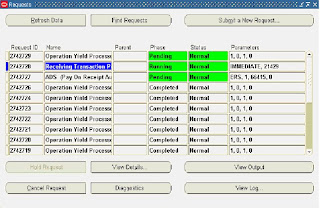
9. Run the Program Pay on receipt auto invoice.(Which Generate Invoice Automatically)
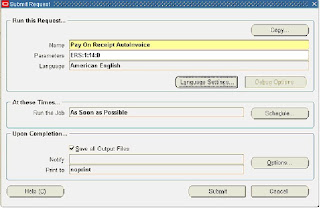
10. View the Status of the program and refresh if not completed.
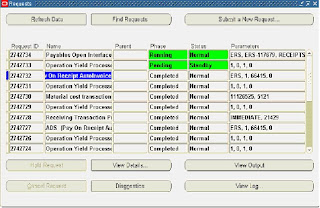
11. Go to Payables: InvoiceàEntry àInvoice
Query with the Invoice Num ERS%

12. Validate the Invoice .After Validate Enable the creating Accounting check box.
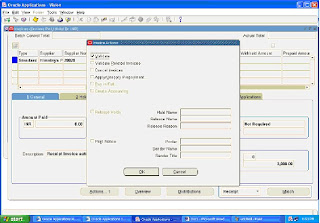
13.See The Account
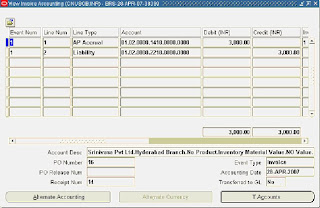
14. Enable the check box Pay in full. And Pres ok.
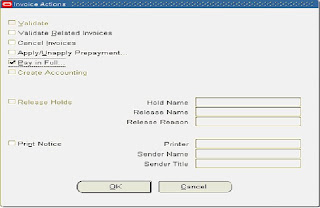
15. Select the Bank and Go to Actions
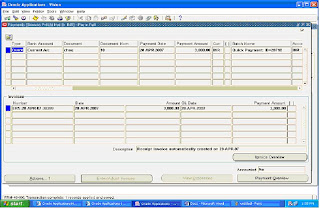
16. Enable the check box Create Accounting and press ok.
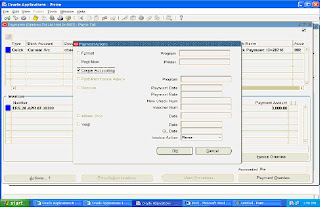
17. See the Account Created.
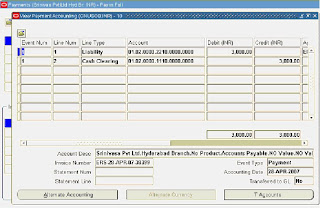
18. Now see the invoice status validated, accounted and amount paid.
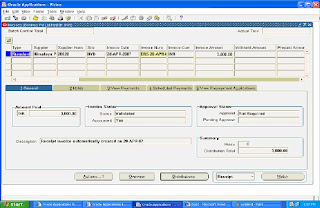
19. Go to Cash Management: Bank Statementsà Manual clearing. àClear Transactions
Find the Bank Account.
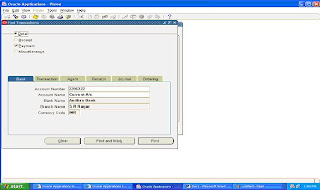
20. Enable the Transaction and press Clear Transaction Button.
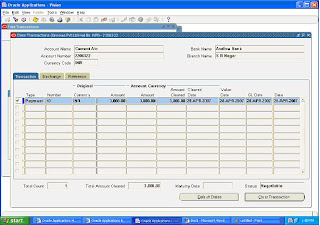
21. Go to Payables: PaymentàEntryàPayment
Query with Payment Date
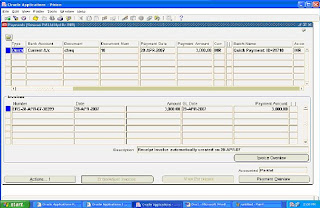
22. Go to actions, enable Create Accounting and press ok.
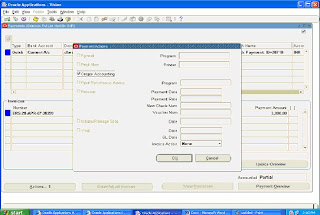
23. See the Account created.
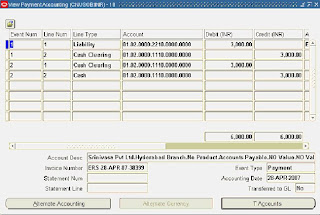
24. Run: Payables Transfer to General Ledger.
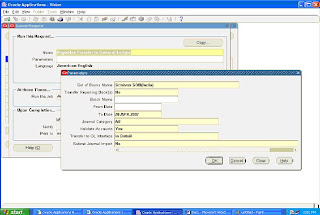
25.View the Request status and refers if not completed.
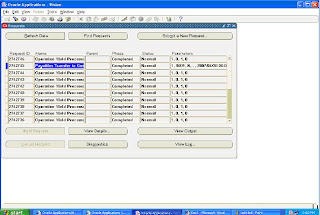
26.Got to GL:JournalàImportàRun
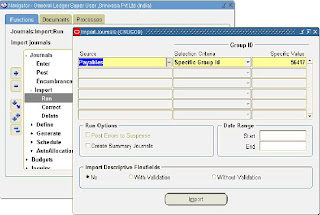
27.View the request status and refers if not completed.
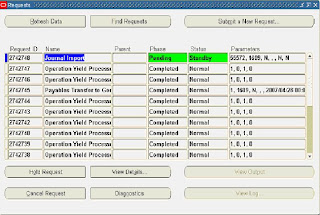
28. Go to JournalsàEnter .Find with Source as Payables.
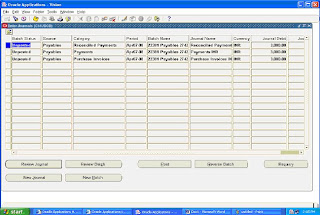
29.Now We can Post the journals.

2. Give Shipments

3. Give Distributions

4. Approve PO

5. See the status of the PO In The header level: It is approved.

6. Go to the ReceivingàReceipts

7. Give the sub inv and stock locator where you want store the goods. And Save.

8. View the request status and refresh If not Completed.

9. Run the Program Pay on receipt auto invoice.(Which Generate Invoice Automatically)

10. View the Status of the program and refresh if not completed.

11. Go to Payables: InvoiceàEntry àInvoice
Query with the Invoice Num ERS%

12. Validate the Invoice .After Validate Enable the creating Accounting check box.

13.See The Account

14. Enable the check box Pay in full. And Pres ok.

15. Select the Bank and Go to Actions

16. Enable the check box Create Accounting and press ok.

17. See the Account Created.

18. Now see the invoice status validated, accounted and amount paid.

19. Go to Cash Management: Bank Statementsà Manual clearing. àClear Transactions
Find the Bank Account.

20. Enable the Transaction and press Clear Transaction Button.

21. Go to Payables: PaymentàEntryàPayment
Query with Payment Date

22. Go to actions, enable Create Accounting and press ok.

23. See the Account created.

24. Run: Payables Transfer to General Ledger.

25.View the Request status and refers if not completed.

26.Got to GL:JournalàImportàRun

27.View the request status and refers if not completed.

28. Go to JournalsàEnter .Find with Source as Payables.

29.Now We can Post the journals.
Author:
Cnu Bandi
Thursday, June 7, 2007
Secondary Tracking Segment
Secondary Tracking Segment is a Flex field qualified added in the 11.5.10 release. The secondary tracking segment is used in the revaluation, translation, and fiscal year-end close processes. The system will automatically maintain unrealized gain/loss, retained earnings, and cumulative translation adjustments by unique pairs of balancing segment and secondary tracking segment values. you can assign Secondary tracking segment flex field qualifier to an segment which haven’t assigned Natural account, balensing Segment and inter company.
Author:
Cnu Bandi
Friday, May 25, 2007
Assets Frequently Asked Questions
1. What are the different ways of adding assets in FA?
2. How do we depreciate Assets in Oracle Applications?
3. What is the significance of asset books in FA? Types?
4.What is ment by retire asset? How do we retire assets in Oracle applications?
5. What are the various Journal Entries generated through fixed assets
6.At what level FA is implemented?
7.What is the profile used to secure asset register?
8.What are the asset types in FA Module?
9.What are the different calendars used in FA Module?
10.Is FA Supports Multi _org?
11.What is ment by Roll back depreciation?
12.What are the mandatory flexfiels used in FA?
13.What are the depreciation methods used in FA module?
14.What is ment by prorate convention?
15.What is the use of allow amortized changes check box?
16.What is the difference between Quick addition and detail addition?
17.What is ment by projection?
18.What is ment by what-if analysis?
19.What is ment by leased asset?
20.What is ment by depreciation override? Can we override depreciation?
21.What is ment by physical inventory reconciliation?
22.Tell me something about asset insurance?
23.What is ment by asset revaluation?
24.In prepare mass additions window what are available Q names?
25.what is the difference between initial mass copy and periodic mass copy?
26.what is internal retairment?
27.What experience do you have in FA Module Implementation?
28.What do you know about FA to GL cycle?
2. How do we depreciate Assets in Oracle Applications?
3. What is the significance of asset books in FA? Types?
4.What is ment by retire asset? How do we retire assets in Oracle applications?
5. What are the various Journal Entries generated through fixed assets
6.At what level FA is implemented?
7.What is the profile used to secure asset register?
8.What are the asset types in FA Module?
9.What are the different calendars used in FA Module?
10.Is FA Supports Multi _org?
11.What is ment by Roll back depreciation?
12.What are the mandatory flexfiels used in FA?
13.What are the depreciation methods used in FA module?
14.What is ment by prorate convention?
15.What is the use of allow amortized changes check box?
16.What is the difference between Quick addition and detail addition?
17.What is ment by projection?
18.What is ment by what-if analysis?
19.What is ment by leased asset?
20.What is ment by depreciation override? Can we override depreciation?
21.What is ment by physical inventory reconciliation?
22.Tell me something about asset insurance?
23.What is ment by asset revaluation?
24.In prepare mass additions window what are available Q names?
25.what is the difference between initial mass copy and periodic mass copy?
26.what is internal retairment?
27.What experience do you have in FA Module Implementation?
28.What do you know about FA to GL cycle?
Thursday, May 17, 2007
Multi - Org Setup
Multi-Org is a server-side (applications and database) enhancement that enables multiple business units in an enterprise to use a single installation of Oracle Applications products while keeping transaction data separate and secure. The Multi-Org enhancement uses native database views to build a security layer on top of a single installation of Oracle Applications. In Oracle Applications Release 11i,
Basic Business Needs
The Multi-Org enhancement to Oracle Applications provides features necessary to satisfy the following basic business needs. You should be able to:
• Use a single installation of any Oracle Applications product to support any number of business units, even if those business units use different sets of books.
• Support any number of business units within a single installation of Oracle Applications.
• Secure access to data so that users can access only information that is relevant to them.
• Procure products from an operating unit that uses one set of book, but receive them from another operating unit using a different set of books.
• Sell products from an operating unit that uses one set of books, but ship them from another operating unit using a different set of books, automatically recording the appropriate intercompany sales by posting intercompany accounts payable and accounts receivable invoices.
• Report at any level of the organizational structure
The Below is the structure of the Multi-Org
1.Login as sysadmin responsibility
2.Ddefine required responsibilities
Navigation:security->responsibility->define
3.Define user and assign responsibilities to the user.
N:Security->user->define.
4.Login as GL Responsibility
5.Define accounting flexfield
N:setup->financials->flexfield->key->segments
6.Give values for your segments
N:setup->financials->flexfield->key->values.
7.Define Currency
N:setup->Curriencies->define
8.Define Calender.
N:Setup->financials->calender->Type/Accounting
9.Create SOB N:Setup->financials->book->define
10.Login as HRMS responsibility.
11.Define a location N:Work Structure->Location
12.Define a Business Group
N:Works Structure->organization->description
13.Set the following Profile Options to all your responsibilities
HR:security
HR:bisiness group
HR:User Type
GL:Set of books name
14.Login As Inventoruy responsibility
15.Create legal entity
N:Setup->organizations->organizations
16.Create Operatiing unit N:Setup->organizations->organizations
17.Set Profile option Mo:Operating unit for all responsibilites which is worked at operating unit level.
18.Create Work day calender
19.Create inventory Organization.
N:Setup->organizations->organizations
20.Login as sysadmin and run replicate seed data program.
Basic Business Needs
The Multi-Org enhancement to Oracle Applications provides features necessary to satisfy the following basic business needs. You should be able to:
• Use a single installation of any Oracle Applications product to support any number of business units, even if those business units use different sets of books.
• Support any number of business units within a single installation of Oracle Applications.
• Secure access to data so that users can access only information that is relevant to them.
• Procure products from an operating unit that uses one set of book, but receive them from another operating unit using a different set of books.
• Sell products from an operating unit that uses one set of books, but ship them from another operating unit using a different set of books, automatically recording the appropriate intercompany sales by posting intercompany accounts payable and accounts receivable invoices.
• Report at any level of the organizational structure
The Below is the structure of the Multi-Org
1.Login as sysadmin responsibility
2.Ddefine required responsibilities
Navigation:security->responsibility->define
3.Define user and assign responsibilities to the user.
N:Security->user->define.
4.Login as GL Responsibility
5.Define accounting flexfield
N:setup->financials->flexfield->key->segments
6.Give values for your segments
N:setup->financials->flexfield->key->values.
7.Define Currency
N:setup->Curriencies->define
8.Define Calender.
N:Setup->financials->calender->Type/Accounting
9.Create SOB N:Setup->financials->book->define
10.Login as HRMS responsibility.
11.Define a location N:Work Structure->Location
12.Define a Business Group
N:Works Structure->organization->description
13.Set the following Profile Options to all your responsibilities
HR:security
HR:bisiness group
HR:User Type
GL:Set of books name
14.Login As Inventoruy responsibility
15.Create legal entity
N:Setup->organizations->organizations
16.Create Operatiing unit N:Setup->organizations->organizations
17.Set Profile option Mo:Operating unit for all responsibilites which is worked at operating unit level.
18.Create Work day calender
19.Create inventory Organization.
N:Setup->organizations->organizations
20.Login as sysadmin and run replicate seed data program.
Monday, April 30, 2007
Note On Indian localization
Oracle Applications was developed as a Global product.Because of this reason it does not supported by some acts like customs,central excise,vat,cst...etc which are mandatory according to Indian Laws.
All other contries are also having some contry specific requirements. To meet the above requirements Oracle developes software named patches.We can add this patches to the base product of the oracle applications.
Indian Localization is also one patch which meets the contry specific requirements.
What is India Localization Product?
India Localization is a solution built over Oracle E-Business Suite, Oracle's e-business applications software product, that provides Clients in India with the most comprehensive solution to comply with the India specific tax requirements as specified by Central Excise, Customs, Sales Tax and VAT, and Income Tax, (to the extent of tax deduction at source and generation of Depreciation Schedule for fixed assets). India Localization product also provides valuable information that can be used for statutory and management reporting.
What Does India Localization Product Do?The product uses its own tax engine, for handling taxes applicable across 'Procure to Pay' and 'Order to Cash' transactions.
In India Localization, taxes are defaulted based on the pre-determined setup (Tax Defaultation). Tax amounts are calculated based on precedence such as transaction base value, tax on tax, or assessable value as specified by tax authority (Tax Calculation). The Tax Amount is considered for inventory valuation, recoverability and accounting based on the pre-determined recoverability and accounting rules (Tax Accounting and Recoverability). Details of recoverable tax amount are recorded as part of the repository (Tax Recording). This information can further be used to calculate the final tax liability arising on settlement at the end of the tax period (Tax Settlement) and for statutory reporting (Tax Reporting).
Components of India Localization Product
Tax Defaultation
Tax Calculation and Recovery
Accounting for India Localization Taxes
Recording and Reporting Tax Information
All other contries are also having some contry specific requirements. To meet the above requirements Oracle developes software named patches.We can add this patches to the base product of the oracle applications.
Indian Localization is also one patch which meets the contry specific requirements.
What is India Localization Product?
India Localization is a solution built over Oracle E-Business Suite, Oracle's e-business applications software product, that provides Clients in India with the most comprehensive solution to comply with the India specific tax requirements as specified by Central Excise, Customs, Sales Tax and VAT, and Income Tax, (to the extent of tax deduction at source and generation of Depreciation Schedule for fixed assets). India Localization product also provides valuable information that can be used for statutory and management reporting.
What Does India Localization Product Do?The product uses its own tax engine, for handling taxes applicable across 'Procure to Pay' and 'Order to Cash' transactions.
In India Localization, taxes are defaulted based on the pre-determined setup (Tax Defaultation). Tax amounts are calculated based on precedence such as transaction base value, tax on tax, or assessable value as specified by tax authority (Tax Calculation). The Tax Amount is considered for inventory valuation, recoverability and accounting based on the pre-determined recoverability and accounting rules (Tax Accounting and Recoverability). Details of recoverable tax amount are recorded as part of the repository (Tax Recording). This information can further be used to calculate the final tax liability arising on settlement at the end of the tax period (Tax Settlement) and for statutory reporting (Tax Reporting).
Components of India Localization Product
Tax Defaultation
Tax Calculation and Recovery
Accounting for India Localization Taxes
Recording and Reporting Tax Information
Thursday, April 26, 2007
Form personalization
Introduction to Form personalization
Form personalization is a declarative feature that alters the look and behavior of the oracle forms with out changing base code. This concept was introduced in the release 11.5.10. All E-Business suit forms can be personalized
By using form personalization you can:1. Display your own terminology.
2. Stream lines the screen interaction.
3. Implement security policies.
4. Add your own validation and error messages.
There are some limitations:
1. You can only change what oracle forms allows to be changed at run time.
2. You can only respond to limited trigger events only.
3. Your changes may be overridden by oracle base code.
To Be Continued in the next post.........
Form personalization is a declarative feature that alters the look and behavior of the oracle forms with out changing base code. This concept was introduced in the release 11.5.10. All E-Business suit forms can be personalized
By using form personalization you can:1. Display your own terminology.
2. Stream lines the screen interaction.
3. Implement security policies.
4. Add your own validation and error messages.
There are some limitations:
1. You can only change what oracle forms allows to be changed at run time.
2. You can only respond to limited trigger events only.
3. Your changes may be overridden by oracle base code.
To Be Continued in the next post.........
Wednesday, April 25, 2007
AIM Documents .............
Hai Friends...as a functional consultant we should know about AIM.Please find the AIM Documents list..............
Business Process Architecture (BP)
BP.010 Define Business and Process Strategy
BP.020 Catalog and Analyze Potential Changes
BP.030 Determine Data Gathering Requirements
BP.040 Develop Current Process Model
BP.050 Review Leading Practices
BP.060 Develop High-Level Process Vision
BP.070 Develop High-Level Process Design
BP.080 Develop Future Process Model
BP.090 Document Business Procedure
Business Requirements Definition (RD)
RD.010 Identify Current Financial and Operating Structure
RD.020 Conduct Current Business Baseline
RD.030 Establish Process and Mapping Summary
RD.040 Gather Business Volumes and Metrics
RD.050 Gather Business Requirements
RD.060 Determine Audit and Control Requirements
RD.070 Identify Business Availability Requirements
RD.080 Identify Reporting and Information Access Requirements
Business Requirements Mapping
BR.010 Analyze High-Level Gaps
BR.020 Prepare mapping environment
BR.030 Map Business requirements
BR.040 Map Business Data
BR.050 Conduct Integration Fit Analysis
BR.060 Create Information Model
BR.070 Create Reporting Fit Analysis
BR.080 Test Business Solutions
BR.090 Confirm Integrated Business Solutions
BR.100 Define Applications Setup
BR.110 Define security Profiles
Application and Technical Architecture (TA)
TA.010 Define Architecture Requirements and Strategy
TA.020 Identify Current Technical Architecture
TA.030 Develop Preliminary Conceptual Architecture
TA.040 Define Application Architecture
TA.050 Define System Availability Strategy
TA.060 Define Reporting and Information Access Strategy
TA.070 Revise Conceptual Architecture
TA.080 Define Application Security Architecture
TA.090 Define Application and Database Server Architecture
TA.100 Define and Propose Architecture Subsystems
TA.110 Define System Capacity Plan
TA.120 Define Platform and Network Architecture
TA.130 Define Application Deployment Plan
TA.140 Assess Performance Risks
TA.150 Define System Management Procedures
Module Design and Build (MD)
MD.010 Define Application Extension Strategy
MD.020 Define and estimate application extensions
MD.030 Define design standards
MD.040 Define Build Standards
MD.050 Create Application extensions functional design
MD.060 Design Database extensions
MD.070 Create Application extensions technical design
MD.080 Review functional and Technical designs
MD.090 Prepare Development environment
MD.100 Create Database extensions
MD.110 Create Application extension modules
MD.120 Create Installation routines
Data Conversion (CV)
CV.010 Define data conversion requirements and strategy
CV.020 Define Conversion standards
CV.030 Prepare conversion environment
CV.040 Perform conversion data mapping
CV.050 Define manual conversion procedures
CV.060 Design conversion programs
CV.070 Prepare conversion test plans
CV.080 Develop conversion programs
CV.090 Perform conversion unit tests
CV.100 Perform conversion business objects
CV.110 Perform conversion validation tests
CV.120 Install conversion programs
CV.130 Convert and verify data
Documentation (DO)
DO.010 Define documentation requirements and strategy
DO.020 Define Documentation standards and procedures
DO.030 Prepare glossary
DO.040 Prepare documentation environment
DO.050 Produce documentation prototypes and templates
DO.060 Publish user reference manual
DO.070 Publish user guide
DO.080 Publish technical reference manual
DO.090 Publish system management guide
Business System Testing (TE)
TE.010 Define testing requirements and strategy
TE.020 Develop unit test script
TE.030 Develop link test script
TE.040 Develop system test script
TE.050 Develop systems integration test script
TE.060 Prepare testing environments
TE.070 Perform unit test
TE.080 Perform link test
TE.090 perform installation test
TE.100 Prepare key users for testing
TE.110 Perform system test
TE.120 Perform systems integration test
TE.130 Perform Acceptance test
PERFORMACE TESTING(PT)
PT.010 - Define Performance Testing Strategy
PT.020 - Identify Performance Test Scenarios
PT.030 - Identify Performance Test Transaction
PT.040 - Create Performance Test Scripts
PT.050 - Design Performance Test Transaction Programs
PT.060 - Design Performance Test Data
PT.070 - Design Test Database Load Programs
PT.080 - Create Performance Test TransactionPrograms
PT.090 - Create Test Database Load Programs
PT.100 - Construct Performance Test Database
PT.110 - Prepare Performance Test Environment
PT.120 - Execute Performance Test
Adoption and Learning (AP)
AP.010 - Define Executive Project Strategy
AP.020 - Conduct Initial Project Team Orientation
AP.030 - Develop Project Team Learning Plan
AP.040 - Prepare Project Team Learning Environment
AP.050 - Conduct Project Team Learning Events
AP.060 - Develop Business Unit Managers’Readiness Plan
AP.070 - Develop Project Readiness Roadmap
AP.080 - Develop and Execute CommunicationCampaign
AP.090 - Develop Managers’ Readiness Plan
AP.100 - Identify Business Process Impact onOrganization
AP.110 - Align Human Performance SupportSystems
AP.120 - Align Information Technology Groups
AP.130 - Conduct User Learning Needs Analysis
AP.140 - Develop User Learning Plan
AP.150 - Develop User Learningware
AP.160 - Prepare User Learning Environment
AP.170 - Conduct User Learning Events
AP.180 - Conduct Effectiveness Assessment
Production Migration (PM)
PM.010 - Define Transition Strategy
PM.020 - Design Production Support Infrastructure
PM.030 - Develop Transition and Contingency Plan
PM.040 - Prepare Production Environment
PM.050 - Set Up Applications
PM.060 - Implement Production Support Infrastructure
PM.070 - Verify Production Readiness
PM.080 - Begin Production
PM.090 - Measure System Performance
PM.100 - Maintain System
PM.110 - Refine Production System
PM.120 - Decommission Former Systems
PM.130 - Propose Future Business Direction
PM.140 - Propose Future Technical Direction
Business Process Architecture (BP)
BP.010 Define Business and Process Strategy
BP.020 Catalog and Analyze Potential Changes
BP.030 Determine Data Gathering Requirements
BP.040 Develop Current Process Model
BP.050 Review Leading Practices
BP.060 Develop High-Level Process Vision
BP.070 Develop High-Level Process Design
BP.080 Develop Future Process Model
BP.090 Document Business Procedure
Business Requirements Definition (RD)
RD.010 Identify Current Financial and Operating Structure
RD.020 Conduct Current Business Baseline
RD.030 Establish Process and Mapping Summary
RD.040 Gather Business Volumes and Metrics
RD.050 Gather Business Requirements
RD.060 Determine Audit and Control Requirements
RD.070 Identify Business Availability Requirements
RD.080 Identify Reporting and Information Access Requirements
Business Requirements Mapping
BR.010 Analyze High-Level Gaps
BR.020 Prepare mapping environment
BR.030 Map Business requirements
BR.040 Map Business Data
BR.050 Conduct Integration Fit Analysis
BR.060 Create Information Model
BR.070 Create Reporting Fit Analysis
BR.080 Test Business Solutions
BR.090 Confirm Integrated Business Solutions
BR.100 Define Applications Setup
BR.110 Define security Profiles
Application and Technical Architecture (TA)
TA.010 Define Architecture Requirements and Strategy
TA.020 Identify Current Technical Architecture
TA.030 Develop Preliminary Conceptual Architecture
TA.040 Define Application Architecture
TA.050 Define System Availability Strategy
TA.060 Define Reporting and Information Access Strategy
TA.070 Revise Conceptual Architecture
TA.080 Define Application Security Architecture
TA.090 Define Application and Database Server Architecture
TA.100 Define and Propose Architecture Subsystems
TA.110 Define System Capacity Plan
TA.120 Define Platform and Network Architecture
TA.130 Define Application Deployment Plan
TA.140 Assess Performance Risks
TA.150 Define System Management Procedures
Module Design and Build (MD)
MD.010 Define Application Extension Strategy
MD.020 Define and estimate application extensions
MD.030 Define design standards
MD.040 Define Build Standards
MD.050 Create Application extensions functional design
MD.060 Design Database extensions
MD.070 Create Application extensions technical design
MD.080 Review functional and Technical designs
MD.090 Prepare Development environment
MD.100 Create Database extensions
MD.110 Create Application extension modules
MD.120 Create Installation routines
Data Conversion (CV)
CV.010 Define data conversion requirements and strategy
CV.020 Define Conversion standards
CV.030 Prepare conversion environment
CV.040 Perform conversion data mapping
CV.050 Define manual conversion procedures
CV.060 Design conversion programs
CV.070 Prepare conversion test plans
CV.080 Develop conversion programs
CV.090 Perform conversion unit tests
CV.100 Perform conversion business objects
CV.110 Perform conversion validation tests
CV.120 Install conversion programs
CV.130 Convert and verify data
Documentation (DO)
DO.010 Define documentation requirements and strategy
DO.020 Define Documentation standards and procedures
DO.030 Prepare glossary
DO.040 Prepare documentation environment
DO.050 Produce documentation prototypes and templates
DO.060 Publish user reference manual
DO.070 Publish user guide
DO.080 Publish technical reference manual
DO.090 Publish system management guide
Business System Testing (TE)
TE.010 Define testing requirements and strategy
TE.020 Develop unit test script
TE.030 Develop link test script
TE.040 Develop system test script
TE.050 Develop systems integration test script
TE.060 Prepare testing environments
TE.070 Perform unit test
TE.080 Perform link test
TE.090 perform installation test
TE.100 Prepare key users for testing
TE.110 Perform system test
TE.120 Perform systems integration test
TE.130 Perform Acceptance test
PERFORMACE TESTING(PT)
PT.010 - Define Performance Testing Strategy
PT.020 - Identify Performance Test Scenarios
PT.030 - Identify Performance Test Transaction
PT.040 - Create Performance Test Scripts
PT.050 - Design Performance Test Transaction Programs
PT.060 - Design Performance Test Data
PT.070 - Design Test Database Load Programs
PT.080 - Create Performance Test TransactionPrograms
PT.090 - Create Test Database Load Programs
PT.100 - Construct Performance Test Database
PT.110 - Prepare Performance Test Environment
PT.120 - Execute Performance Test
Adoption and Learning (AP)
AP.010 - Define Executive Project Strategy
AP.020 - Conduct Initial Project Team Orientation
AP.030 - Develop Project Team Learning Plan
AP.040 - Prepare Project Team Learning Environment
AP.050 - Conduct Project Team Learning Events
AP.060 - Develop Business Unit Managers’Readiness Plan
AP.070 - Develop Project Readiness Roadmap
AP.080 - Develop and Execute CommunicationCampaign
AP.090 - Develop Managers’ Readiness Plan
AP.100 - Identify Business Process Impact onOrganization
AP.110 - Align Human Performance SupportSystems
AP.120 - Align Information Technology Groups
AP.130 - Conduct User Learning Needs Analysis
AP.140 - Develop User Learning Plan
AP.150 - Develop User Learningware
AP.160 - Prepare User Learning Environment
AP.170 - Conduct User Learning Events
AP.180 - Conduct Effectiveness Assessment
Production Migration (PM)
PM.010 - Define Transition Strategy
PM.020 - Design Production Support Infrastructure
PM.030 - Develop Transition and Contingency Plan
PM.040 - Prepare Production Environment
PM.050 - Set Up Applications
PM.060 - Implement Production Support Infrastructure
PM.070 - Verify Production Readiness
PM.080 - Begin Production
PM.090 - Measure System Performance
PM.100 - Maintain System
PM.110 - Refine Production System
PM.120 - Decommission Former Systems
PM.130 - Propose Future Business Direction
PM.140 - Propose Future Technical Direction
Tuesday, April 24, 2007
Oracle Implementation Methodalagy
SUMMARY NOTES ON AIM
Application Implementation Method is a provan approach, which specifies all the activities which are required to implement oracle applications successfully.
The scope of the AIM is enterprise wide.
There are eleven processes of implementation.
1. Business Process Architecture[BP]
This phase explains
Existing business practices
Catalog change practices
Leading practices
Future practices
2. Business Requirement Definition[RD]
This phase explains about the
Base line questionnaire and
The gathering of information.
3. Business Requirement Mapping[BR]
In this phase we can match all the requirements of business with the standard functionality of the oracle applications.
If all the requirements match with oracle standard (with out customization) functionality then, it is called as vanilla implementation).
4. Application and Technical Architecture [TA]
Explains the infrastructure requirements to implement oracle applications.
For example:
desktops
software
hardware
Application Implementation Method is a provan approach, which specifies all the activities which are required to implement oracle applications successfully.
The scope of the AIM is enterprise wide.
There are eleven processes of implementation.
1. Business Process Architecture[BP]
This phase explains
Existing business practices
Catalog change practices
Leading practices
Future practices
2. Business Requirement Definition[RD]
This phase explains about the
Base line questionnaire and
The gathering of information.
3. Business Requirement Mapping[BR]
In this phase we can match all the requirements of business with the standard functionality of the oracle applications.
If all the requirements match with oracle standard (with out customization) functionality then, it is called as vanilla implementation).
4. Application and Technical Architecture [TA]
Explains the infrastructure requirements to implement oracle applications.
For example:
desktops
software
hardware
people...etc
5. Build and Module Design[MD]
In this phase concentrate on developing the new functionality which is required by the client.
This is called customization.
In this phase explains how to design a forms, database and reports...
6. Data Conversion:[CV]
Is the process of converting or transferring the data from legacy system to oracle applications? This is called as data migration.
Ex: transferring the closing balances of the previous year as an opening balances to next year.
7. Documentation:[DO]
I
n this phase we have to prepare module wise user guides and implementation manuals which helps in the implementation.
8. Business System Testing:[TE]
A process of validating the setup’s and the functionality by a tester to certify its status is allied business system testing. It is done by a functional consultant.
9. Performance Testing:[PT]
Performance testing means evaluation of transaction saving time, transaction retrieval times. It is done by a technical team.
10; Adoption and Learning.[AP]
This phase explains about the removal of the legacy system of the client. The entire user should be trained with new oracle applications. In this phase we have to prepare user manuals.
11. Production Migration[PM]
A process of decommissioning of legacy system and the usage of new oracle application system begins in this phase.
5. Build and Module Design[MD]
In this phase concentrate on developing the new functionality which is required by the client.
This is called customization.
In this phase explains how to design a forms, database and reports...
6. Data Conversion:[CV]
Is the process of converting or transferring the data from legacy system to oracle applications? This is called as data migration.
Ex: transferring the closing balances of the previous year as an opening balances to next year.
7. Documentation:[DO]
I
n this phase we have to prepare module wise user guides and implementation manuals which helps in the implementation.
8. Business System Testing:[TE]
A process of validating the setup’s and the functionality by a tester to certify its status is allied business system testing. It is done by a functional consultant.
9. Performance Testing:[PT]
Performance testing means evaluation of transaction saving time, transaction retrieval times. It is done by a technical team.
10; Adoption and Learning.[AP]
This phase explains about the removal of the legacy system of the client. The entire user should be trained with new oracle applications. In this phase we have to prepare user manuals.
11. Production Migration[PM]
A process of decommissioning of legacy system and the usage of new oracle application system begins in this phase.
Subscribe to:
Comments (Atom)


